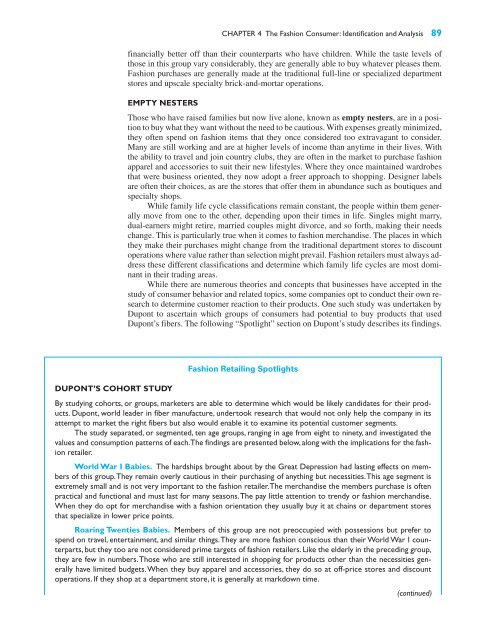Chapter 4 - Pearson
Chapter 4 - Pearson
Chapter 4 - Pearson
You also want an ePaper? Increase the reach of your titles
YUMPU automatically turns print PDFs into web optimized ePapers that Google loves.
dia76827_ch04.qxd 11/29/04 7:55 PM Page 89<br />
CHAPTER 4 The Fashion Consumer: Identification and Analysis 89<br />
financially better off than their counterparts who have children. While the taste levels of<br />
those in this group vary considerably, they are generally able to buy whatever pleases them.<br />
Fashion purchases are generally made at the traditional full-line or specialized department<br />
stores and upscale specialty brick-and-mortar operations.<br />
EMPTY NESTERS<br />
Those who have raised families but now live alone, known as empty nesters, are in a position<br />
to buy what they want without the need to be cautious. With expenses greatly minimized,<br />
they often spend on fashion items that they once considered too extravagant to consider.<br />
Many are still working and are at higher levels of income than anytime in their lives. With<br />
the ability to travel and join country clubs, they are often in the market to purchase fashion<br />
apparel and accessories to suit their new lifestyles. Where they once maintained wardrobes<br />
that were business oriented, they now adopt a freer approach to shopping. Designer labels<br />
are often their choices, as are the stores that offer them in abundance such as boutiques and<br />
specialty shops.<br />
While family life cycle classifications remain constant, the people within them generally<br />
move from one to the other, depending upon their times in life. Singles might marry,<br />
dual-earners might retire, married couples might divorce, and so forth, making their needs<br />
change. This is particularly true when it comes to fashion merchandise. The places in which<br />
they make their purchases might change from the traditional department stores to discount<br />
operations where value rather than selection might prevail. Fashion retailers must always address<br />
these different classifications and determine which family life cycles are most dominant<br />
in their trading areas.<br />
While there are numerous theories and concepts that businesses have accepted in the<br />
study of consumer behavior and related topics, some companies opt to conduct their own research<br />
to determine customer reaction to their products. One such study was undertaken by<br />
Dupont to ascertain which groups of consumers had potential to buy products that used<br />
Dupont’s fibers. The following “Spotlight” section on Dupont’s study describes its findings.<br />
Fashion Retailing Spotlights<br />
DUPONT’S COHORT STUDY<br />
By studying cohorts, or groups, marketers are able to determine which would be likely candidates for their products.<br />
Dupont, world leader in fiber manufacture, undertook research that would not only help the company in its<br />
attempt to market the right fibers but also would enable it to examine its potential customer segments.<br />
The study separated, or segmented, ten age groups, ranging in age from eight to ninety, and investigated the<br />
values and consumption patterns of each.The findings are presented below, along with the implications for the fashion<br />
retailer.<br />
World War I Babies. The hardships brought about by the Great Depression had lasting effects on members<br />
of this group.They remain overly cautious in their purchasing of anything but necessities.This age segment is<br />
extremely small and is not very important to the fashion retailer.The merchandise the members purchase is often<br />
practical and functional and must last for many seasons.The pay little attention to trendy or fashion merchandise.<br />
When they do opt for merchandise with a fashion orientation they usually buy it at chains or department stores<br />
that specialize in lower price points.<br />
Roaring Twenties Babies. Members of this group are not preoccupied with possessions but prefer to<br />
spend on travel, entertainment, and similar things.They are more fashion conscious than their World War I counterparts,<br />
but they too are not considered prime targets of fashion retailers. Like the elderly in the preceding group,<br />
they are few in numbers.Those who are still interested in shopping for products other than the necessities generally<br />
have limited budgets.When they buy apparel and accessories, they do so at off-price stores and discount<br />
operations. If they shop at a department store, it is generally at markdown time.<br />
(continued)
















